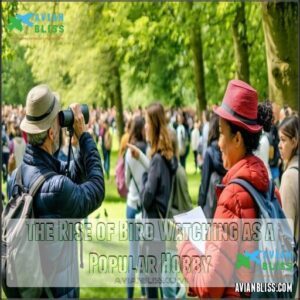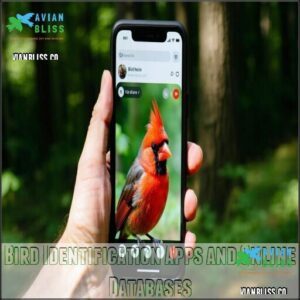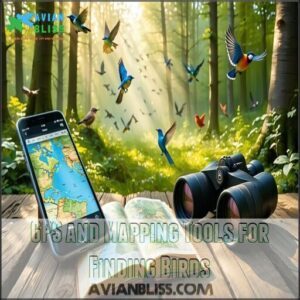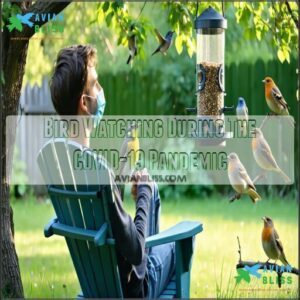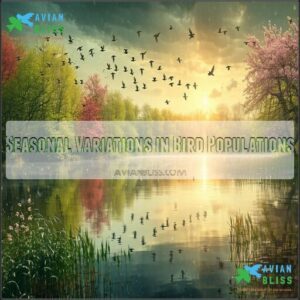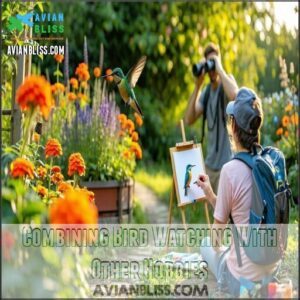This site is supported by our readers. We may earn a commission, at no cost to you, if you purchase through links.
 You’ll find bird watching popular because it connects you with nature while requiring minimal equipment to start.
You’ll find bird watching popular because it connects you with nature while requiring minimal equipment to start.
It’s scientifically proven to reduce stress hormones like cortisol, and you’re joining nearly 96 million Americans who’ve discovered this accessible hobby.
Bird watching lets you witness remarkable biological adaptations up close, from the peregrine falcon’s 200 mph dive to the tiny hummingbird’s 1,260 heartbeats per minute.
You can practice anywhere – from urban parks to wilderness areas – making it a perfect escape valve for our digital lives.
The thrill of spotting a rare species becomes addictive, like collecting living treasures hidden in plain sight, which can lead to a perfect escape and a sense of discovering living treasures.
Table Of Contents
- Key Takeaways
- The Rise of Bird Watching as a Popular Hobby
- Accessibility and Low Barriers to Entry
- Connection With Nature and Environmental Awareness
- Technological Advancements Enhancing The Bird Watching Experience
- Health Benefits and Stress Relief
- Bird Watching During The COVID-19 Pandemic
- Diversity and Adaptability of Bird Watching
- Frequently Asked Questions (FAQs)
- Is bird watching becoming more popular?
- What is birdwatching & why is it important?
- Why is birding so popular?
- Why is birdwatching so popular in the UK?
- Why should you go bird watching?
- Why is photography important for birdwatching?
- Why is birdwatching popular?
- When did bird watching become popular?
- Why do people enjoy birds?
- Who is the target audience for bird watching?
- Conclusion
Key Takeaways
- You’ll find bird watching offers a powerful connection to nature with minimal barriers to entry – it requires little equipment to start and can be practiced anywhere from urban parks to wilderness areas.
- You’ll join a rapidly growing community that spans diverse demographics, with participation expanding from 12 million Americans in 1980 to over 96 million today.
- You’ll experience proven health benefits including reduced stress hormones like cortisol, improved mental well-being, and the physical exercise that comes naturally with exploring birding locations.
- You’ll develop greater environmental consciousness as you observe local ecosystems, with many birders contributing to citizen science projects and conservation efforts that protect habitats.
The Rise of Bird Watching as a Popular Hobby
You’ll find yourself among a rapidly growing community of nature enthusiasts, as bird watching has expanded from 12 million participants in 1980 to over 96 million Americans today.
You’re part of a diverse demographic trend that spans all ages and backgrounds, with the average birder now younger at 47 years old and women making up 45% of participants.
This reflects bird watching’s universal appeal and accessibility, making it an activity that can be enjoyed by people from all walks of life.
Growing Interest in Nature-Based Activities
Flocking to nature-based activities, Americans are rediscovering the simple joy of observing wildlife in their natural habitats.
Nature beckons, and Americans are answering the call, finding joy in the wild wings that grace our everyday world.
Bird watching has emerged as a frontrunner in this outdoor recreation renaissance, offering a perfect blend of accessibility and wonder.
You’ll find that connecting with nature through bird watching provides both mental restoration and a deeper appreciation for local ecosystems.
Conservation awareness grows naturally as you become familiar with the birds in your area.
This connection fosters a desire to protect their habitats and contributes to the broader ecotourism growth we’re seeing nationwide.
- Bird watching serves as an accessible entry point to nature observation, requiring minimal equipment to start and offering immediate rewards of discovery.
Nature’s appeal is universal and timeless—watching a cardinal flit between branches or hearing a warbler’s song creates moments of genuine connection that digital experiences simply can’t replicate.
It’s nature therapy for modern times, providing a sense of wonder and promoting conservation awareness through accessible means.
Increased Participation Across Demographics
Building on our shared love for nature, birdwatching has dramatically expanded its reach across all demographics.
Recent statistics reveal that 96 million Americans now engage in birding—representing an impressive 37% of the population aged 16 and older.
You’ll find birdwatching’s appeal spans all age demographics, from curious teenagers to active seniors, with the average age shifting from 49 to 47 over the past decade.
Gender parity has improved substantially too, with women now comprising 45% of all birders, up from 31% in 2000.
Ethnic diversity in birdwatching continues to grow, with Asian Americans showing the highest participation rate at 47%.
Income levels no longer create barriers—people across all economic backgrounds can participate with minimal equipment.
These generational shifts reflect birdwatching’s increasing accessibility and inclusivity. Whether you’re using high-end binoculars or a smartphone app, everyone can now experience the joy of spotting feathered friends.
Bird Watching Organizations Report Membership Growth
As bird watching soars in popularity across different groups, conservation organizations are reporting remarkable membership growth nationwide.
The National Audubon Society now estimates over 50 million Americans consider themselves bird enthusiasts.
Major birding organizations have implemented successful retention strategies through:
- Community science programs where members contribute valuable conservation data
- Inclusive membership options accommodating various income levels and demographics
- Digital transformation with mobile apps and virtual events expanding accessibility
- Family-focused programming creating multi-generational engagement opportunities
These organizations have seen participation increase by nearly 45% since 2016, with funding sources diversifying through grants, donations, and merchandise sales.
Their program expansion now reaches urban areas previously underserved by conservation initiatives, with millions participating, as birdwatching is booming as a popular hobby worldwide.
The volunteer engagement has strengthened as well, with many members contributing thousands of hours annually to habitat restoration and bird monitoring efforts.
Statistics Showing Bird Watching’s Popularity Surge
While once considered a niche pastime, bird watching has soared in popularity with participation growth jumping from 45 million Americans in 2016 to an impressive 96 million by 2022.
These birdwatching statistics reveal fascinating demographic shifts across age groups, with participation nearly equal between men and women.
The economic impact is equally stunning—birders collectively spent $107.6 billion in 2022, with $93 billion going toward equipment spending alone.
This hobby generates $279 billion in total economic output while supporting 1.4 million jobs nationwide.
Americans dedicated 7.5 billion activity days to bird watching in 2022, with backyard birders averaging 67 days annually.
This growth includes a notable increase in youth bird watching, indicating a broadening appeal across generations.
Accessibility and Low Barriers to Entry
Bird watching’s minimal entry barriers open nature’s door to virtually everyone.
This hobby doesn’t discriminate by age, income, or location—making it one of the most accessible outdoor pursuits available today.
What makes bird watching exceptionally budget-friendly?
- Simple equipment needs: Start with just your eyes and ears—then gradually add affordable binoculars ($30-75) and free identification apps like Merlin or eBird.
- No special venues required: Your backyard, neighborhood park, or urban green space hosts dozens of species waiting to be discovered without travel expenses.
- Learn-as-you-go approach: Unlike activities requiring formal training, birding welcomes self-paced learning through observation, community groups, and online resources.
The inclusive nature of birding extends beyond economics—people with varying physical abilities can participate from accessible viewing platforms, through window watching, or via guided accessible tours.
These areas are often hotspots of biodiversity, providing essential habitat for numerous bird species.
Whether you’re eight or eighty, living in an apartment or rural homestead, bird watching welcomes you with open wings.
Connection With Nature and Environmental Awareness
You’ll find that bird watching naturally connects you to the environment around you, transforming casual observation into meaningful awareness of local ecosystems and conservation needs.
When you regularly observe birds in their natural habitats, you’ll develop a deeper understanding of environmental issues affecting wildlife, prompting many of the 45 million American birders to participate in citizen science projects that directly contribute to conservation efforts.
Appreciation for Local Wildlife and Ecosystems
Through the lens of binoculars, your backyard transforms into a living laboratory of local biodiversity.
Bird watching connects you directly with nature’s intricate web, revealing how each feathered neighbor contributes to ecosystem health.
You’ll notice chickadees controlling garden pests or hummingbirds pollinating your flowers—small yet essential roles in habitat preservation.
This firsthand experience fosters citizen stewardship as you recognize the importance of protecting wildlife corridors and green spaces.
Many birders report that observing backyard birds creates a deeper appreciation for conservation efforts, turning casual observers into passionate advocates for nature.
Habitat conservation initiatives are essential for protecting bird populations.
The more you watch, the more you’ll want to protect.
Increased Environmental Consciousness
Raising your binoculars toward the sky transforms you from casual observer to environmental steward. As you identify species and track migration patterns, environmental awareness naturally follows.
Bird watching creates a direct connection between your weekend hobby and vital conservation efforts. When you witness firsthand how habitat loss affects local bird populations, conservation funding and species protection suddenly become personal missions rather than abstract concepts.
Many birders report that their hobby gradually led them to adopt more sustainable practices in their daily lives.
- 97% of dedicated bird watchers donate time or money to environmental causes, showing how this hobby directly fuels conservation movements.
Bird conservation organizations harness this awareness, converting enthusiasts into advocates for climate impact solutions. The identification skills you develop while spotting chickadees and herons naturally expand into greater knowledge about habitat preservation and the delicate balance of ecosystems everywhere.
Bird Watching as a Form of Eco-Tourism
Looking beyond environmental awareness, when you grab your binoculars and head to renowned birdwatching destinations, you’re participating in a powerful economic force.
The global birdwatching tourism market reached $62.73 billion in 2023 and continues growing at 6.2% annually.
Your sustainable birding adventures directly fund habitat preservation while creating jobs for local communities—birdwatchers spent $107.6 billion on activities in 2022 alone.
This ecotourism impact isn’t just good for birds; it incentivizes conservation funding and wildlife habitat protection, as healthy ecosystems remain economically valuable for the communities that steward them.
Contributing to Citizen Science Projects
Beyond enjoying birds as an eco-tourist, you can transform your hobby into valuable scientific contributions.
Citizen science projects connect birdwatchers directly to conservation efforts, turning casual observations into vital research data.
Your participation makes a real difference:
- eBird – Record sightings that help track migration patterns and population trends
- Christmas Bird Count – Join the world’s longest-running wildlife census
- Project FeederWatch – Monitor winter feeding birds to detect population changes
- Breeding Bird Survey – Help assess reproductive success across different habitats
Despite some accessibility barriers, birdwatching data collection methods have become increasingly user-friendly.
Even beginners can contribute with basic identification skills—your observations help protect the very birds you love watching!
Technological Advancements Enhancing The Bird Watching Experience
You’ll now find identifying that elusive warbler much easier with today’s bird identification apps and high-resolution optics that transform casual observation into precision science.
Modern technology has revolutionized birding, allowing you to instantly access databases, share sightings with online communities, and use GPS mapping tools to locate specific species in your area.
Bird Identification Apps and Online Databases
While connecting with nature, you’ll find technology has revolutionized how we identify our feathered friends.
Modern bird identification apps have transformed smartphones into powerful birding companions with remarkable accuracy.
| App | Key Features | Community Benefits |
|---|---|---|
| Merlin Bird ID | Photo & sound ID, offline functionality | eBird database access |
| Audubon Guide | 800+ species, 3,000+ photos | Real-time identification |
| BirdNET | AI-powered sound recognition | Contributes to citizen science |
These digital guides offer database completeness that paper guides simply can’t match.
You’ll appreciate how community contributions continuously improve these platforms, making birdwatching more accessible and scientifically valuable than ever before.

High-Quality Optics and Camera Equipment
Investing in superior optics transforms your birding experience from casual glances to memorable encounters.
Today’s bird watching equipment combines cutting-edge technology with user-friendly design, making wildlife observation more accessible than ever.
Your birding adventure reaches new heights with quality gear:
- Weather-resistant binoculars with premium image stabilization that reveal the tiniest details on a warbler’s wing, even when your hands aren’t perfectly steady.
Modern birdwatching technology includes everything from lightweight telephoto lenses to cell phone camera adapters that turn your smartphone into a powerful documentation tool.
For enhanced viewing, consider image stabilization binoculars.
Quality binoculars with proper weatherproofing let you continue your passion regardless of conditions.
The difference between standard and premium birdwatching equipment isn’t just about seeing birds—it’s about experiencing them in their full glory, capturing moments you’d otherwise miss.
Social Media and Online Communities for Birders
While high-quality optics help you spot birds in the field, social media has transformed birdwatching from a solitary pursuit into a connected global experience.
Today’s birding community thrives online through platforms where enthusiasts share spectacular photographs and rare sightings. Popular birdwatching apps like eBird let you document discoveries while connecting with like-minded observers worldwide.
Facebook groups and Instagram hashtags have created vibrant birdwatching communities where beginners receive expert advice instantly. Photo sharing has become central to the hobby, with thousands of enthusiasts posting their captures daily.
These online communities also amplify conservation impact, as trending sightings can raise awareness about threatened species and habitats. You’ll find these digital gathering spots particularly valuable when you’re puzzling over an unusual bird—simply upload your photo for quick online ID help from experienced birders who love solving feathered mysteries.
GPS and Mapping Tools for Finding Birds
Why have GPS mapping tools become essential for your birding adventures? Today’s birdwatching apps transform your smartphone into a precision field guide, directing you to birding hotspots with remarkable GPS accuracy.
You’ll discover hidden sanctuaries where rare species nest, with offline maps enabling exploration in remote areas without cell service. Data logging features let you track personal sightings over time, while sharing locations with fellow enthusiasts creates a community experience.
These digital tools complement traditional birdwatching gear, making species identification faster and more reliable. Enthusiasts can find specialized birding products to enhance their experience.
Whether you’re marking territories during migration seasons or finding urban bird havens, GPS technology has revolutionized this growing hobby, connecting you to nature with unprecedented precision. It’s about transforming your smartphone and making the most of birding hotspots with the help of GPS mapping tools and offline maps.
Health Benefits and Stress Relief
When you’re watching birds through your binoculars, you’re actually engaging in a scientifically proven activity that reduces stress hormones like cortisol in your bloodstream.
You’ll notice your breathing naturally slows and your mind clears as you focus on spotting that yellow warbler in the trees, creating a meditative state that provides significant relaxation benefits.
95% of birdwatchers report that this activity offers relaxation benefits, highlighting the relaxation benefits of birdwatching.
Physical Exercise and Outdoor Activity
Beyond spotting rare species with your new bird identification apps, bird watching offers remarkable physical benefits.
Bird watching turns your smartphone into a portal to the winged world, while strengthening your body with every step.
When you track birds, you’re naturally engaging in cardiovascular-boosting outdoor activities that improve your physical endurance. Walking distances of even modest lengths can yield significant calorie burn while exploring trails in pursuit of elusive feathered friends.
Research shows that regular birdwatchers typically walk between 2-5 miles per outing, contributing to improved physical and mental health.
- Trail Exploration Strategy: Start with shorter, well-marked paths near water sources where birds congregate, gradually increasing distance as your stamina builds.
Bird watching transforms exercise from mundane routine into purposeful nature connection—your body gets fit while your mind stays engaged.
Mental Health Improvements and Stress Reduction
Research reveals that bird watching substantially improves mental health through its unique stress-reducing properties.
Your brain’s stress response naturally diminishes when focused on spotting and identifying feathered creatures in their natural habitats.
Nature immersion during birdwatching offers proven benefits:
- Mindfulness Practice – Observing birds requires present-moment awareness that interrupts anxiety cycles and negative thought patterns.
- Cognitive Refreshment – Identifying species exercises your brain while simultaneously allowing mental fatigue recovery.
- Emotional Regulation – Studies show spending time with birds reduces cortisol levels by up to 16%, improving mood and emotional well-being.
This quiet hobby transforms stress into tranquility without expensive equipment or special training.
Bird owners should also be aware of emotional stressors in birds that can impact their well-being.
Social Connections and Community Building
While birding initially seems like a solitary pursuit, how does it foster meaningful social bonds?
Bird watching naturally creates community through shared passion and discovery.
Connection Point Community Benefit Social Impact
You’ll discover that birdwatching relationships often develop organically when you spot a rare species and excitedly point it out to a stranger who becomes a friend.
The birdwatching community welcomes enthusiasts of all experience levels, creating connections across generations and backgrounds.
Whether participating in Christmas Bird Counts or chatting in online forums, these birdwatching friendships enrich the hobby beyond the simple joy of observation.
Cognitive Benefits of Learning and Observation
Bird watching’s cognitive payoffs extend far beyond simple enjoyment.
When you regularly practice bird identification, your brain strengthens essential neural pathways associated with pattern recognition and memory improvement.
Focus enhancement occurs naturally as you train yourself to spot subtle movements among foliage or distinguish between similar species.
Your cognitive functions receive a workout comparable to solving puzzles, with each correct identification building skill development and sensory awareness.
- Research shows birdwatchers demonstrate superior attention to detail and improved recall compared to non-birders, with participants aged 49+ experiencing the most significant benefits in maintaining cognitive health.
Bird Watching During The COVID-19 Pandemic
When you couldn’t venture far during COVID-19 lockdowns, you found solace by watching the feathered visitors in your backyard, joining millions of Americans who turned to bird watching as a safe outdoor activity.
You’ll discover that during this period, interest in local birds soared dramatically, with participation increasing across all demographics as people sought connection with nature while maintaining social distance.
Safe Outdoor Activity During Lockdowns
During COVID-19’s strictest lockdowns, bird watching became America’s safest outdoor escape.
You didn’t need crowds or close contact—just your eyes, maybe binoculars, and nature’s winged companions.
This pandemic-proof hobby offered mental health lifelines when traditional activities disappeared.
While others struggled with isolation, bird watchers discovered local exploration opportunities literally outside their windows—turning neighborhood walks into exciting safari-like adventures during uncertain times.
| Lockdown Birding Benefits | Mental Wellbeing Impact | Safety Features |
|---|---|---|
| Accessible from anywhere | Reduced anxiety | Natural distancing |
| Minimal equipment needed | Connected to nature | Outside airflow |
| Available year-round | Daily purpose | No shared surfaces |
| Family-friendly activity | Mindfulness practice | Low-risk exploration |
Bird watching provided a unique opportunity for people to connect with nature, enjoy outside airflow, and experience natural distancing while minimizing the risk of infection, making it an ideal family-friendly activity during the pandemic.
Renewed Interest in Backyard and Local Birds
Lockdown’s silver lining transformed America’s backyards into thriving avian sanctuaries, with millions discovering the joy of local birding without leaving home. During pandemic restrictions, the bird watching popularity surged as people connected with nature through their windows and patios.
Your backyard became more than just outdoor space—it evolved into a genuine urban sanctuary where you could observe diverse species establishing territories, building nests, and raising young. Bird feeders became the new neighborhood hotspot, drawing everything from colorful cardinals to chatty chickadees.
- According to the 2022 surveys, backyard birding hobby participation jumped 37%, with 96 million Americans engaging in bird watching activities close to home.
This newfound appreciation for backyard habitats contributed substantially to citizen science projects, with smartphone apps making identification accessible to beginners. Many discovered that creating bird-friendly spaces provided both entertainment and meaningful conservation contributions—proving the most fascinating wildlife theater was performing just outside all along.
Virtual Bird Watching Events and Workshops
During the pandemic, virtual bird watching events and workshops soared in popularity, bringing the outdoor experience right into your living room.
Through platforms like Zoom and Facebook Live, you could join expert-led sessions focusing on virtual identification techniques and digital conservation efforts.
These accessible birding programs created thriving online communities where you could share sightings and ask questions.
Various birding apps transformed smartphones into powerful identification tools, while organizations like the Audubon Society offered regular birdwatching events.
The technology wasn’t just educational—it made remote learning an adventure, connecting enthusiasts across continents who shared a passion for our feathered friends.
| Event Type | Description |
|---|---|
| Virtual Tours | Explore global bird habitats remotely |
| Live Talks | Learn from professional ornithologists |
| Online Workshops | Master bird identification skills |
| Digital Challenges | Test your growing knowledge |
| Webinars | Dive deep into specific avian topics |
Bird Watching as a Way to Combat Isolation
During quarantine periods, many found sanctuary in the wings of social birding. Bird watching created meaningful connections when traditional gatherings weren’t possible, offering a shared experience that transcended physical isolation.
- Watching a cardinal’s brilliant plumage flash through your backyard creates an instant conversation starter with fellow enthusiasts online.
You’ll discover how birdwatching benefits extend beyond stress reduction—building community and overcoming loneliness through a hobby that requires nothing more than curiosity and patience.
Diversity and Adaptability of Bird Watching
You’ll find bird watching remarkably adaptable to your lifestyle, whether you’re spotting urban hawks from your apartment window or joining the 45 million Americans who participate across all age groups and locations.
With opportunities spanning from backyard feeders to international expeditions, you can easily combine this flexible hobby with other interests like photography, hiking, or gardening, as demonstrated by the 72% of bird watchers who also enjoy tending plants, making it a hobby that fits well with gardening and other outdoor activities like hiking.
Urban Bird Watching Opportunities
Cities offer surprising havens for bird watching enthusiasts.
The concrete jungle hosts diverse avian species in parks, rooftops, and community gardens. You’ll find bird-friendly cities developing green corridors that support urban bird migration patterns.
Try balcony birding with simple feeders, or join local birding groups that explore city bird habitats.
Urban birdwatching locations are incredibly accessible for beginners—nature’s theater performs daily, just outside your window.
Seasonal Variations in Bird Populations
Experiencing seasonal variations in bird populations transforms birdwatching into a year-round adventure of discovery.
Each season reveals distinct bird behaviors and species as migration patterns shift with changing weather and food availability. Spring brings colorful warblers returning to breeding grounds, while summer reveals busy nesting activities and fledgling birds taking first flights.
Fall presents dramatic southward migrations, and winter introduces unique northern species seeking warmer habitats.
Did you know? The Arctic Tern holds the record for longest migration, traveling approximately 44,000 miles annually between Arctic breeding grounds and Antarctic winter habitats.
Understanding triggers for migration helps predict these avian movements.
Climate impacts continue to alter traditional patterns, making seasonal birdwatching both fascinating and scientifically valuable as you observe these remarkable adaptations across different bird habitats throughout the year.
Bird Watching for All Age Groups and Abilities
While many hobbies favor specific demographics, bird watching stands as a uniquely inclusive activity that welcomes enthusiasts across all age brackets and physical abilities.
From toddlers pointing excitedly at backyard visitors to seniors enjoying their golden years, birdwatching adapts seamlessly to individual capabilities and interests.
- Recent studies show that birdwatching participation spans all generations, with the average birder age at 47 and growing participation among youth birding programs.
Adaptive equipment has revolutionized inclusive birding, with lightweight binoculars, smartphone scopes, and wheelchair-accessible blinds making nature observation possible for everyone.
Senior birding groups often offer seated observation opportunities, while family birding events create intergenerational connections through shared discovery.
To further enhance the experience, consider exploring options for specialized birding gear.
What’s particularly remarkable about birdwatching inclusivity is how the birds themselves don’t discriminate—whether you’re observing from a specialized mobility device or standing in a forest clearing, the same spectacular wing displays and melodious calls await you.
Combining Bird Watching With Other Hobbies
Bird watching combines perfectly with five other popular hobbies, creating rich, multidimensional experiences for enthusiasts of all levels.
You’ll discover that birding isn’t just a standalone activity—it’s a versatile pursuit that enhances your existing interests.
| Complementary Hobby | Benefit | Getting Started |
|---|---|---|
| Birding Photography | Captures detailed memories of rare species | Start with a 300mm zoom lens |
| Birding Gardening | Attracts diverse birds to your property | Plant native berry bushes |
| Hiking | Accesses remote habitats for unique sightings | Research bird-rich trails |
| Birding Art | Develops observational skills through sketching | Begin with field sketches |
You’re not limited to these combinations—many bird watchers incorporate travel journals, meditation practices, and even scientific data collection into their birding adventures.
The versatility makes bird watching an exceptionally adaptable hobby that grows with your interests.
Frequently Asked Questions (FAQs)
Is bird watching becoming more popular?
Like Thoreau’s retreat to Walden Pond, you’re joining a growing movement. Bird watching’s popularity has risen substantially, with participation increasing from 12 million in 1980 to over 45 million Americans today.
What is birdwatching & why is it important?
Birdwatching is the observation and study of birds in their natural habitats.
It’s important because it contributes $279 billion to the economy, supports 4 million jobs, and fosters conservation efforts while offering stress relief.
Why is birding so popular?
You’re drawn to birding because it connects you with nature, requires minimal equipment to start, and offers both solitude and community.
It’s accessible across all ages and provides stress relief while fostering conservation awareness.
Why is birdwatching so popular in the UK?
With 6 million UK residents regularly engaged in birdwatching, you’ll find it’s woven into British cultural DNA.
You can join the RSPB with over 1 million members and connect with nature right in your backyard.
Why should you go bird watching?
You’ll find peace and connection with nature while bird watching.
It’s a hobby that improves your mental wellbeing, supports conservation efforts, and introduces you to a community of fellow enthusiasts sharing your passion.
Why is photography important for birdwatching?
Like capturing lightning in a bottle, photography lets you preserve fleeting bird moments, document sightings, identify species later, and share your discoveries with others. It’s become essential for modern birders.
Why is birdwatching popular?
You’re drawn to birdwatching because it connects you with nature while being accessible to everyone.
It offers stress relief, supports conservation, and creates community through shared experiences of spotting beautiful, fascinating creatures in their natural habitats, which provides a sense of conservation.
When did bird watching become popular?
As quiet as a bird at dawn, birdwatching’s popularity soared in the early 20th century.
You’ll find its mainstream appeal grew markedly during the 1930s-40s, with substantial growth continuing through the 1970s-80s.
Why do people enjoy birds?
You’re drawn to birds for their diverse colors, enchanting songs, and graceful movements in nature.
They’ll offer you stress relief, connection to wildlife, and moments of wonder right in your backyard.
Who is the target audience for bird watching?
Imagine binoculars scanning horizons—that’s birdwatching’s universal appeal.
You’ll find enthusiasts of all ages, with equal numbers of men and women participating.
Asian Americans have the highest engagement rate at 47%, while the average birder is
Conclusion
With nearly 96 million Americans engaging in bird watching, this hobby continues to grow for good reason.
You’ll find that connecting with nature through observing birds improves your mental health while requiring minimal equipment to start.
Whether you’re spotting birds in urban parks or remote wilderness areas, bird watching offers an accessible escape from digital life.
The scientific benefits, from stress reduction to environmental awareness, explain why bird watching remains popular across all demographics and locations.
- https://flickr.com/photos/usfwshq/albums/72177720322338265
- https://www.usgs.gov/labs/bird-banding-laboratory/science/report-a-band
- https://www.history.com/topics/19th-century/victorian-era-timeline
- https://www.nytimes.com/2019/07/17/obituaries/florence-merriam-bailey-overlooked.html
- https://merlin.allaboutbirds.org/

